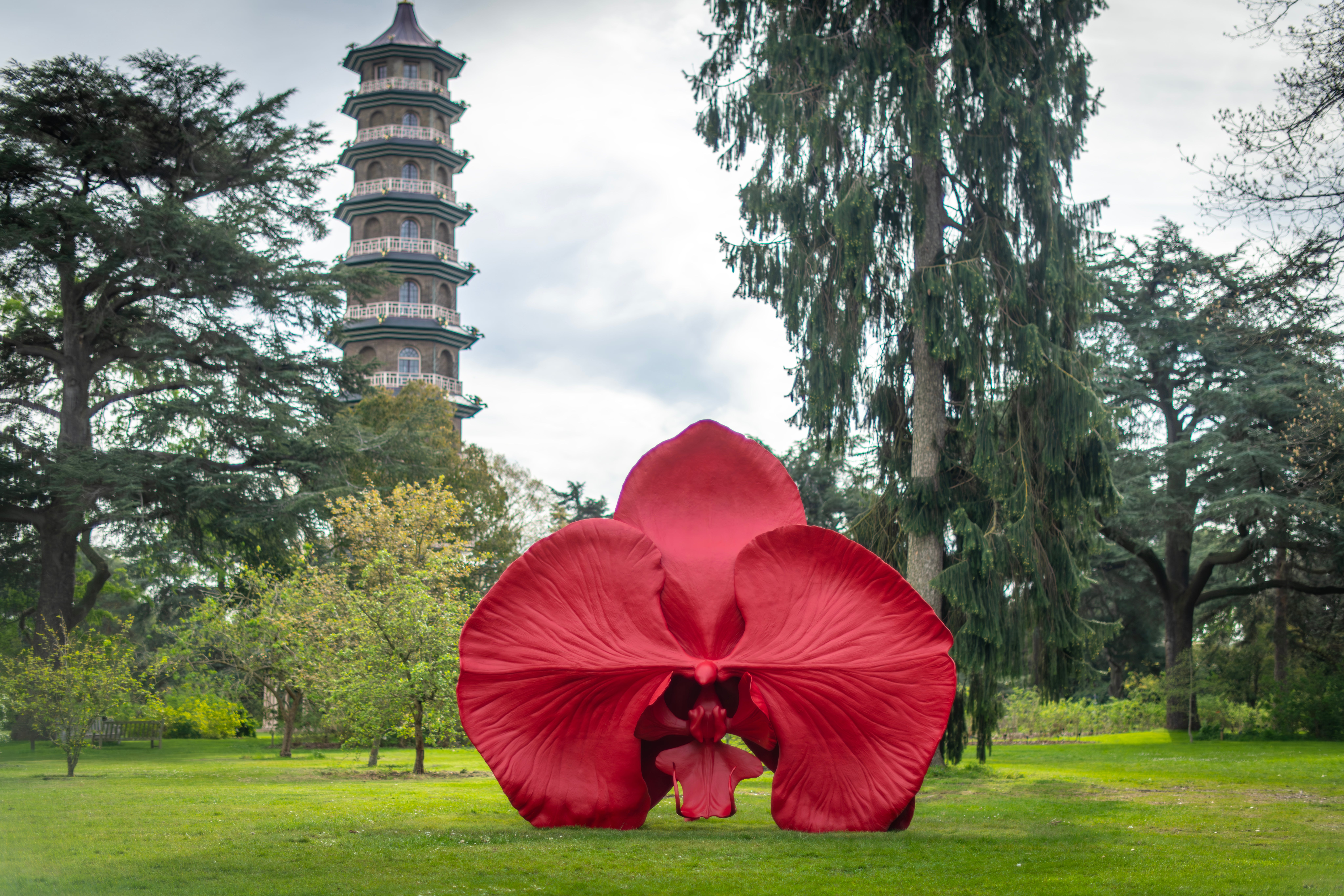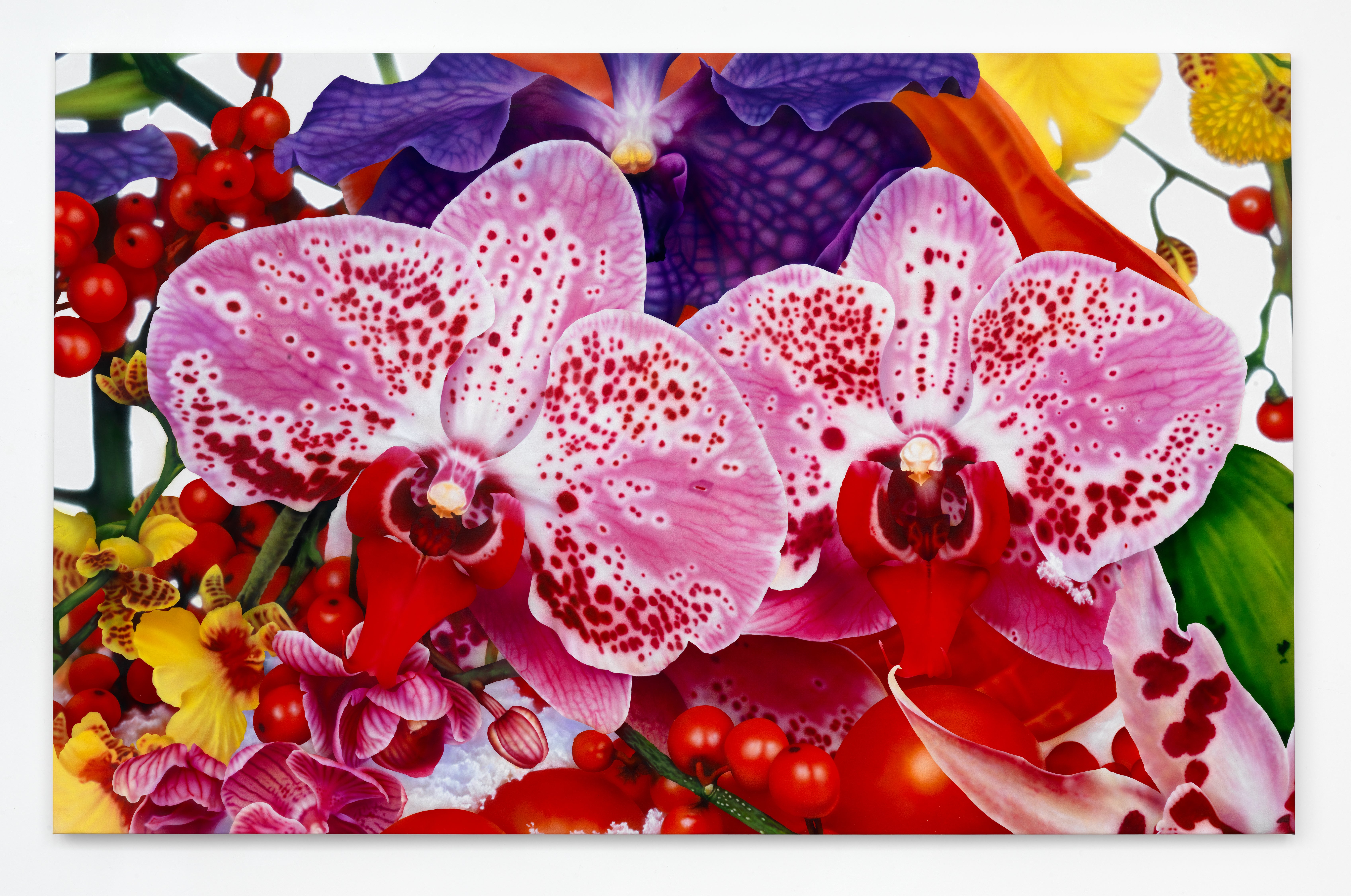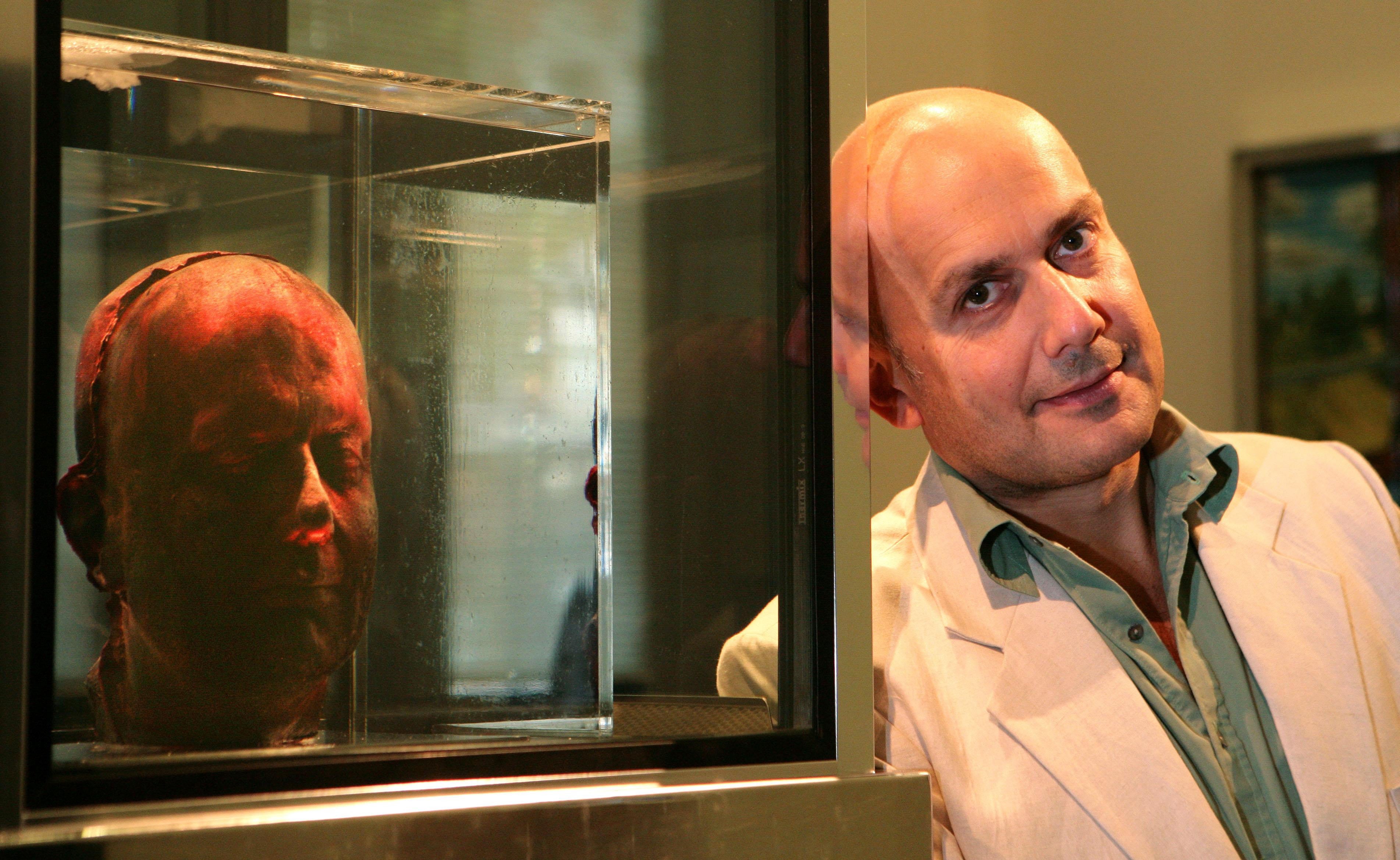From ‘blood heads’ to blooms: how art star Marc Quinn went horticultural
Superstar of the British art world Marc Quinn has brought an element of sensation to his work since the 1990s. That’s no different for his exhibition at Kew Gardens, one of the only dedicated to a single artist in its 265-year history. Mark Hudson takes a tour

I’m walking through Kew Gardens with the artist Marc Quinn. His works are dotted among the dahlias and tulips as part of one of the largest exhibitions devoted to a single artist in Kew’s 265-year history. “Nature is all the things that art should be,” Quinn tells me. “It’s exciting, transgressive, scary.”
A dive into the world of horticulture feels like a mellowing move, even a nod towards middle England, for an artist long seen as among the bad boys of British culture. Quinn was a leading light of the young British artists (YBA) generation whose tabloid-baiting statements, epic partying and flair for manipulating the art market stood the fusty British art scene on its head in the 1990s. Kew may give us access to flora from some of the wildest places on Earth, but it’s presented within a meticulously ordered scientific frame in exquisitely manicured gardens. It’s all a world away from world-rocking YBA works such as Damien Hirst’s dead shark, Tracy Emin’s My Bed and indeed Quinn‘s own extraordinary Self, a cast of his head in 10 pints of his own frozen blood.
As we’re talking, several of his sculptures come into view near one of the majestic Victorian greenhouses. Or rather, they don’t quite come into view. The cut-out forms made from some highly polished material, seem to dematerialise as we approach, so it’s hard to tell what’s real sky and trees, and what’s reflection. As I move up to one of the plant-like shapes I could swear it disappears, so there’s just me, staring back at myself against a verdant backdrop of the Royal Botanic Gardens.
“It’s a portrait of an opium poppy,” says Quinn. “It’s made from stainless steel, so it’s a mirror in the landscape, which is subtly disrupting our view. When it’s in my studio it’s like an empty screen, showing nothing, but here it’s reflecting us back to ourselves in a continual livestream of the landscape. Like a lot of things about our relationship with plants, it’s simultaneously visible and invisible.”
“I hadn’t been here for years when they invited me to talk about having an exhibition,” Quinn says. “And it’s the most amazing place: a working museum of trees and plants with 600 scientists analysing their uses and trying to understand them. But it’s also an incredible living work of art.”
Now 60, bright-eyed and unshaven in a baseball cap and trackies, Quinn seems very at home, setting up his works throughout the vast gardens and in the modern Shirley Sherwood Gallery.
He has created some of the most thought-provoking and controversial representations of the human form of the past half-century, not only the infamous Self – or “blood head” as he and the rest of the world tend to refer to it – but Alison Lapper Pregnant, a marble statue of the armless disabled artist which has been perhaps the most talked about and genuinely moving of the many artworks to have been seen on Trafalgar Square’s Fourth Plinth. Siren (2008), a life-size representation of Kate Moss in a tortuously contorted yoga pose in solid 18-carat gold – and rumoured to have cost £1.5m to create – toyed with that great YBA theme, the massive value accruing to contemporary art. A Surge of Power (Jen Reid), a sculpture of the eponymous protestor, designed to replace the toppled statue of Bristol slave trader Edward Colston, created fierce debate during the Black Lives Matter protests of 2020.
With an element of sensation seeming to naturally accrue to his work, a move into the quieter world of plants must be quite a change – even a relief.

“I’ve been creating images related to horticulture and nature since the early 1990s,” says Quinn. “The earliest work in the show is The Origin of the Species from 1993, where I took the mould from my ‘blood head’ and remade it using frozen coconut water – replacing my blood with the ‘blood’ of a plant”; an idea he justifies in a rather technical aside: “The water breeds nutrients, which allow the nut to germinate.” This haunting image stands at the centre of the exhibition’s main indoor space.
“One of my themes is the interconnectedness of all life, which most of the time we don’t even consider. Our attitude to plants is one of save and squander. We obsessively fetishise one kind of plant, while we’re chomping on a burger that’s contributing to the extinction of vast numbers of others. These are things that are in our lives that we don’t think about. So to explore them through a show at Kew with existing works and specially created new works has been a great opportunity.”
Quinn’s starting point for the exhibition was Kew’s herbarium, an extraordinary location little seen by the public, with cast iron walkways and spiral staircases leading between banks of tiny wooden drawers containing centuries’ worth of meticulously catalogued seed samples. Opening a drawer at random, the visitor may find themselves looking at a desiccated seed pod collected in the 18th century with the original quill pen description thrown in alongside.
“It’s like a Victorian prison, full of plant samples,” says Quinn. “And they’re still being sent in by members of the public. Professional specialists press them in the time-honoured way, but folded so they show as many aspects of the plant as possible, the front and backs of the leaves, so they can be interpreted as easily as possible by the scientists who work at Kew.”
When Quinn asked for samples of plants that have been used in cancer treatment, he was offered six pressed herbarium samples. The resulting sculptures, which expand these fragile specimens to two or metres high in stainless steel, are not only “portraits” of these medicinal plants, but their very form embodies the processes of medical research.

“You get these eccentric shapes which have been evolved through chance in the way they were folded, which brings an element of mystery. When you look at them from the side, the weird shapes at the edges look like a barcode.” An accidental evocation, perhaps, of the commercial exploitation that’s at the heart of our relationship with plants. “Even the most modern drugs involve plants that have been re-synthesised. But when you put a pill in your mouth you think about something that’s made in a factory, rather than about plants.”
Quinn, for all his fondness for a very knowing approximation of youth-casual style, bears a touch of the professorial, with his quizzical air and fondness for intellectual contradictions. So it comes as no surprise to learn that his father is an eminent physicist. Does his Kew project feel like a return, perhaps, to the family business?
“I think the reason I felt confident using scientific processes in my art, from those very early works with frozen blood, is that I lived with science when I was growing up, hanging out in my father’s lab and seeing how things were done. There’s an aesthetic to science as well as a process, and I’ve always felt comfortable drawing on that. People look on them as opposing fields, but I’ve always felt that art and science could crossover in ways that haven’t yet been explored.”
That scientific background helps explain Quinn’s empathetic ability to get under the skin of the way we feel about our bodies, which has kept works like Self and Alison Lapper Pregnant feeling fresh, while much YBA art now feels very much of its time. Yet there’s also a great deal of the showman about Quinn, an instinct for what will touch a public nerve: in the scale of his work (Alison Lapper is over three metres high and weighs 15 tons) and the involvement of immensely famous people, such as Moss. His Bristol statue attracted much criticism, but it showed he hadn’t abandoned the YBA taste for provocation, and isn’t ready for pipe and slippers quite yet.
I felt from a very young age that art was the way I should express myself
While the other members of the group, which included not just Hirst and Emin, but Sarah Lucas, Gavin Turk and the Chapman brothers, all went to art school, as do the vast majority of British artists, Quinn took a more academic path, studying art history at Cambridge. “I felt from a very young age that art was the way I should express myself, without knowing how I would do that or if it was even possible to be an artist.” He took the Oxbridge route simply because that was what staff at his boarding school, Millfield, “told me to do. Someone in my year got a place to study at Saint Martin’s (the leading London art school), which woke me up to the fact that there’s a whole art world out there. But I’d already signed on to do art history, and I thought it would be interesting to see what had happened in art before me, and not try to make things in a vacuum. I still think it was a really good decision.”
He kept producing art throughout his time at Cambridge, and on graduating moved to London, hitting the capital’s art scene “at the right moment, when a lot of young artists were trying to do stuff”. These included Damien Hirst staging exhibitions, such as the groundbreaking Freeze, in unused office buildings, and the emergence of a generation of younger, more streetwise art dealers. Quinn signed with one of them, Jay Jopling, whose White Cube is generally seen as the YBA gallery par excellence. Yet it was only with the creation of Self that he hit his stride. With its rendering of Quinn’s stupefied, slightly bloated features in glistening, deep crimson ice, it’s a work that still makes an immediate, unsettling impact. And once you’ve absorbed the basics of what it is, no further explanation is necessary: it’s one piece of conceptual art that everyone gets instantly.

“It’s a total self-portrait,” Quinn says. “It’s the form of my head, made from my own body. The form and the content are one.” And can he remember the moment he had the idea? “I woke up one morning. I’d been thinking about all these things, blood and portraiture, and there was the idea fully formed. Of course, from having the idea to making it happen is the big step. But once it was done, everything rocketed from there.”
The fact that the AIDS crisis was then at its height gave the work a troubling edge. “It was a time of real vulnerability, when blood signified death. And I was trying to reclaim it for life. I like making things that seem to be one thing, but are actually another. You have what looks like a severed head, but actually celebrates life, in the body’s capacity to endlessly remake itself.”
Subsequent scientific breakthroughs have, he says, made the work even more relevant. “You can take a single cell from that head and trace the DNA back to the beginning of life on Earth. Not only is it made of me and looks like me, it’s a genetic library of me which can tell you about my health, and what may happen to me during my lifetime.”
The theme of humanity’s vexed relationship with nature is explored in the Kew exhibition from the sublime – “portraits” of miniature bonsai trees blown up to five metres high in cast bronze – to the almost ridiculous – bunches of flowers displayed in supermarket freezer cabinets. The former represent our desire “to find comfort in a little world we’ve created that’s under our control”, but seen on a monumental scale; the latter our mania for idealising certain kinds of plant life. “The flowers will stay looking perfect forever, preserved by a machine that destroys nature. That sums up our relationship with plants. We destroy and we create, we create and we destroy. It’s a fundamental contradiction in the human character. And hopefully we create just a bit more than we destroy.”
Marc Quinn: Light into Life is at Kew Gardens from 4 May to 29 September






Join our commenting forum
Join thought-provoking conversations, follow other Independent readers and see their replies
0Comments